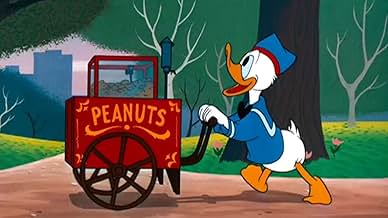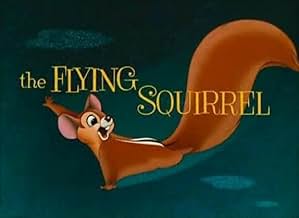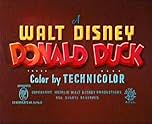Añade un argumento en tu idiomaDonald is pushing his peanut cart through the park when a flying squirrel drops in. Donald gets him to help tie his sign to a tree by promising a peanut, but when it turns out to be a bad nu... Leer todoDonald is pushing his peanut cart through the park when a flying squirrel drops in. Donald gets him to help tie his sign to a tree by promising a peanut, but when it turns out to be a bad nut, Donald won't make good, and the battle with the squirrel is on.Donald is pushing his peanut cart through the park when a flying squirrel drops in. Donald gets him to help tie his sign to a tree by promising a peanut, but when it turns out to be a bad nut, Donald won't make good, and the battle with the squirrel is on.
- Dirección
- Guión
- Reparto principal
James MacDonald
- The Flying Squirrel
- (sin acreditar)
- …
Reseñas destacadas
A Walt Disney DONALD DUCK Cartoon.
Peanut vendor Donald tries to cheat THE FLYING SQUIRREL who helps him in a park - with predictable results.
This little film is unremarkable, but still enjoyable. The title character is undeniably cute, but would not return for any subsequent Disney cartoons. Clarence "Ducky" Nash supplies Donald's voice.
Walt Disney (1901-1966) was always intrigued by drawings. As a lad in Marceline, Missouri, he sketched farm animals on scraps of paper; later, as an ambulance driver in France during the First World War, he drew figures on the sides of his vehicle. Back in Kansas City, along with artist Ub Iwerks, Walt developed a primitive animation studio that provided animated commercials and tiny cartoons for the local movie theaters. Always the innovator, his ALICE IN CARTOONLAND series broke ground in placing a live figure in a cartoon universe. Business reversals sent Disney & Iwerks to Hollywood in 1923, where Walt's older brother Roy became his lifelong business manager & counselor. When a mildly successful series with Oswald The Lucky Rabbit was snatched away by the distributor, the character of Mickey Mouse sprung into Walt's imagination, ensuring Disney's immortality. The happy arrival of sound technology made Mickey's screen debut, STEAMBOAT WILLIE (1928), a tremendous audience success with its use of synchronized music. The SILLY SYMPHONIES soon appeared, and Walt's growing crew of marvelously talented animators were quickly conquering new territory with full color, illusions of depth and radical advancements in personality development, an arena in which Walt's genius was unbeatable. Mickey's feisty, naughty behavior had captured millions of fans, but he was soon to be joined by other animated companions: temperamental Donald Duck, intellectually-challenged Goofy and energetic Pluto. All this was in preparation for Walt's grandest dream - feature length animated films. Against a blizzard of doomsayers, Walt persevered and over the next decades delighted children of all ages with the adventures of Snow White, Pinocchio, Bambi, Peter Pan and Mr. Toad. Walt never forgot that his fortunes were all started by a mouse, or that simplicity of message and lots of hard work always pay off.
Peanut vendor Donald tries to cheat THE FLYING SQUIRREL who helps him in a park - with predictable results.
This little film is unremarkable, but still enjoyable. The title character is undeniably cute, but would not return for any subsequent Disney cartoons. Clarence "Ducky" Nash supplies Donald's voice.
Walt Disney (1901-1966) was always intrigued by drawings. As a lad in Marceline, Missouri, he sketched farm animals on scraps of paper; later, as an ambulance driver in France during the First World War, he drew figures on the sides of his vehicle. Back in Kansas City, along with artist Ub Iwerks, Walt developed a primitive animation studio that provided animated commercials and tiny cartoons for the local movie theaters. Always the innovator, his ALICE IN CARTOONLAND series broke ground in placing a live figure in a cartoon universe. Business reversals sent Disney & Iwerks to Hollywood in 1923, where Walt's older brother Roy became his lifelong business manager & counselor. When a mildly successful series with Oswald The Lucky Rabbit was snatched away by the distributor, the character of Mickey Mouse sprung into Walt's imagination, ensuring Disney's immortality. The happy arrival of sound technology made Mickey's screen debut, STEAMBOAT WILLIE (1928), a tremendous audience success with its use of synchronized music. The SILLY SYMPHONIES soon appeared, and Walt's growing crew of marvelously talented animators were quickly conquering new territory with full color, illusions of depth and radical advancements in personality development, an arena in which Walt's genius was unbeatable. Mickey's feisty, naughty behavior had captured millions of fans, but he was soon to be joined by other animated companions: temperamental Donald Duck, intellectually-challenged Goofy and energetic Pluto. All this was in preparation for Walt's grandest dream - feature length animated films. Against a blizzard of doomsayers, Walt persevered and over the next decades delighted children of all ages with the adventures of Snow White, Pinocchio, Bambi, Peter Pan and Mr. Toad. Walt never forgot that his fortunes were all started by a mouse, or that simplicity of message and lots of hard work always pay off.
I do love Donald Duck, and he was my main reason for watching The Flying Squirrel, as well as my love for Disney and animation. The Flying Squirrel is a little predictable perhaps, but the animation is beautiful, with a lot of colour and vibrancy, and the music is typically energetic as you would expect. The Flying Squirrel manages to be reasonably amusing, like with Donald in the peanut shell, but above all very cute. Donald is great, cantankerous, greedy yet very funny, and the squirrel is one of the most adorable(and clever) little animals I've ever seen in a cartoon. All in all, unremarkable perhaps in the story, but it is worth a look and recommended. 8/10 Bethany Cox
Donald Duck is selling peanuts and other snacks in the park, and he is spotted by a flying squirrel. He asked the squirrel to help him put up a banner in exchange for one peanut. However, the peanut Donald gave the squirrel was a dud, and he didn't want to give it a new one. So, as usual, it's the back and forth fight between Donald and the animal again - nothing new and nothing too funny.
Donald really had it coming when he wouldn't let the squirrel have one extra peanut, instead, goes to an all-out war with the rodent. All this quarreling really has gotten old and all the bad luck Donald Duck endures is really repeated stuff. Even the flying squirrel was annoying - reminded me too much of the pesky Chip N' Dale.
Grade D---
Donald really had it coming when he wouldn't let the squirrel have one extra peanut, instead, goes to an all-out war with the rodent. All this quarreling really has gotten old and all the bad luck Donald Duck endures is really repeated stuff. Even the flying squirrel was annoying - reminded me too much of the pesky Chip N' Dale.
Grade D---
¿Sabías que...?
- CuriosidadesWhile real flying squirrels are really just gliding squirrels, the one in this short seems to be able to fly like a bird, even hovering and changing direction in midair. Five years later, the world would be introduced to another animated squirrel, Rocky, who could fly in this way. Possibly Jay Ward, creator of Rocky the Flying Squirrel, was inspired by this short.
- ConexionesEdited into Donald Duck's Cartoon Mania (1978)
Selecciones populares
Inicia sesión para calificar y añadir a tu lista para recibir recomendaciones personalizadas
Detalles
- Duración7 minutos
- Relación de aspecto
- 1.37 : 1
Contribuir a esta página
Sugerir un cambio o añadir el contenido que falta

Principal laguna de datos
By what name was The Flying Squirrel (1954) officially released in Canada in English?
Responde



















